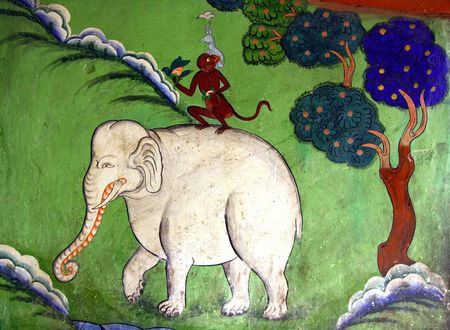Meditation Practice and the Yoga of Self Transformation
In my exposition on the Yoga of Self Transformation, we covered a number of practices under Mental Transformation. Briefly, the practices are around silence, solitude, abandon, resolve, listening, concentration, and gazing. Many people email me about the correct way of meditating and say that they are unable to control their mind and meditate. We have reached a point where I will now start elaborating on the meditation practice itself.
If you make an attempt to carry out the aforesaid practices, you will make a quantum leap in your ability to meditate. In this post, I would like to share with you a story, an anecdote if you will, as this story gives you the essence of meditation practice.
An unhappy but rich woman, used to the superstitious ways of living, approached a sadhu once. The sadhu, however, was an average thinker in the garb of a sage. He could talk about material matters with worldly people, so they felt a certain relief after talking to him. The sadhu thought since people offered him money and stuff, there was no harm in listening to them. That was his bread and butter, in fact. And people thought they will gain some respite from sharing their problems with the sadhu.
So, a woman once went to the sadhu with a long list of problems and complaints. Her problems seemed to have sprung out of nothing and her issues were petty. You can cure a disease or treat a patient, but how do you cure someone who is actually healthy? The woman was unhappy in spite of everything she had. She had good health, a decent family, savings, a home, almost everything. The sadhu thought there truly was nothing he could give the lady, certainly, there was no panacea. But he did not want the lady to return empty-handed either.
After a long pause, he said to the lady, “I will give you a very powerful ancient talisman. This will solve all your problems. This must be kept a secret.”
The woman concurred.
He gave her a copper coin with a hole in it. He further asked her to bury it near the roots of a peepul tree on the full moon night.
“But, for the talisman to work, there is a condition that must be fulfilled,” he said.
“When you are burying the coin, you must not think of any white elephant with three legs, a lame monkey or a talking frog,” he added. “If you think of any of these even for a moment, the remedy will fail.”
The woman offered sweets, gold, and clothes to the sadhu and left happily. The full moon night was ten days away and she reminded herself every day to not think about a three-legged elephant, lame monkey, or talking frog. On the night she was to use the talisman, however, the only thoughts that hit her mind were of the three prohibited things.
Go figure.
The Essence of Meditation Practice
The talisman did not work and she had no one to blame. Had the sadhu not mentioned what not to think, it probably would have never even occurred to her to think of a white elephant with three legs or a talking frog. When you focus too much on what you do not want in your life or think about things that give you grief, you automatically attract those things to your life.
This story tells you everything you need to know about strengthening your meditation practice. When you lay emphasis on what you ought not to think or do while practicing meditation, you will feel uneasy, restless, and distracted. To discover your mind’s natural and unmodulated state, another expression for samadhi, you need to learn to build upon your meditation practice with ease. Just gently focusing on the object of concentration and abandoning all intellectual examination will help you slip into that state of bliss, but the results can only come with a disciplined meditation practice.
You can now read the two types of meditation practice and thereafter you may also want to read the four primary hurdles in meditation practices and the process of overcoming them.
If you commit to a solid meditation practice, who can stop you? If you choose to not listen to your mind, who else is talking?
Peace.
Swami
A GOOD STORY
There were four members in a household. Everybody, Somebody, Anybody and Nobody. A bill was overdue. Everybody thought Somebody would do it. Anybody could have done it but Nobody did it.
Don't leave empty-handed, consider contributing.It's a good thing to do today.









Comments & Discussion
12 COMMENTS
Please login to read members' comments and participate in the discussion.